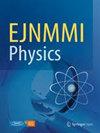肝细胞癌的动力学 18F-FDG PET/CT 成像:双输入四室模型
IF 3
2区 医学
Q2 RADIOLOGY, NUCLEAR MEDICINE & MEDICAL IMAGING
引用次数: 0
摘要
内质网在葡萄糖代谢中发挥着重要作用,但在通过18F-氟-2-脱氧-d-葡萄糖PET/CT对肝细胞癌(HCC)进行动力学估计时,尚未对内质网进行探讨。我们初步使用了一个关于内质网的双输入四室(4C)模型进行动力学估算,以区分来自 24 名 HCC 患者的 28 个肿瘤和背景肝组织。此外,4C 模型的参数图像是由一名在传统代谢 PET/CT 检查中呈阴性结果的患者生成的。与双输入三室(3C)模型相比,4C模型具有更好的拟合质量、更接近的运输速率常数(K1)和去磷酸化速率常数(k6/k4),以及在HCC和背景肝组织中不同的清除速率常数(k2)和磷酸化速率常数(k3)。4C模型中的K1、k2、k3和肝动脉灌注指数(HPI)以及3C模型中的k3、HPI和血液体积分数(Vb)在HCC和背景肝组织之间存在显著差异(均P < 0.05)。同时,4C 模型还提供了用于区分 HCC 的其他动力学参数。从最常见到最不常见的前十个基因的诊断性能依次为HPI(4C)、Vb(3C)、HPI(3C)、SUVmax、k5(4C)、k3(3C)、k2(4C)、v(4C)、K1(4C)和Vb(4C)。此外,一名在传统代谢 PET/CT 中显示阴性结果的患者在 4C 模型中的参数图像为阳性。带有内质网的4C模型比3C模型表现更好,在动力学估算中产生了更多有用的参数,可用于区分HCC和背景肝组织。本文章由计算机程序翻译,如有差异,请以英文原文为准。
Kinetic 18F-FDG PET/CT imaging of hepatocellular carcinoma: a dual input four-compartment model
The endoplasmic reticulum plays an important role in glucose metabolism and has not been explored in the kinetic estimation of hepatocellular carcinoma (HCC) via 18F-fluoro-2-deoxy-d-glucose PET/CT. A dual-input four-compartment (4C) model, regarding endoplasmic reticulum was preliminarily used for kinetic estimation to differentiate 28 tumours from background liver tissue from 24 patients with HCC. Moreover, parameter images of the 4C model were generated from one patient with negative findings on conventional metabolic PET/CT. Compared to the dual-input three-compartment (3C) model, the 4C model has better fitting quality, a close transport rate constant (K1) and a dephosphorylation rate constant (k6/k4), and a different removal rate constant (k2) and phosphorylation rate constant (k3) in HCC and background liver tissue. The K1, k2, k3, and hepatic arterial perfusion index (HPI) from the 4C model and k3, HPI, and volume fraction of blood (Vb) from the 3C model were significantly different between HCC and background liver tissues (all P < 0.05). Meanwhile, the 4C model yielded additional kinetic parameters for differentiating HCC. The diagnostic performance of the top ten genes from the most to least common was HPI(4C), Vb(3C), HPI(3C), SUVmax, k5(4C), k3(3C), k2(4C), v(4C), K1(4C) and Vb(4C). Moreover, a patient who showed negative findings on conventional metabolic PET/CT had positive parameter images in the 4C model. The 4C model with the endoplasmic reticulum performed better than the 3C model and produced additional useful parameters in kinetic estimation for differentiating HCC from background liver tissue.
求助全文
通过发布文献求助,成功后即可免费获取论文全文。
去求助
来源期刊

EJNMMI Physics
Physics and Astronomy-Radiation
CiteScore
6.70
自引率
10.00%
发文量
78
审稿时长
13 weeks
期刊介绍:
EJNMMI Physics is an international platform for scientists, users and adopters of nuclear medicine with a particular interest in physics matters. As a companion journal to the European Journal of Nuclear Medicine and Molecular Imaging, this journal has a multi-disciplinary approach and welcomes original materials and studies with a focus on applied physics and mathematics as well as imaging systems engineering and prototyping in nuclear medicine. This includes physics-driven approaches or algorithms supported by physics that foster early clinical adoption of nuclear medicine imaging and therapy.
 求助内容:
求助内容: 应助结果提醒方式:
应助结果提醒方式:


